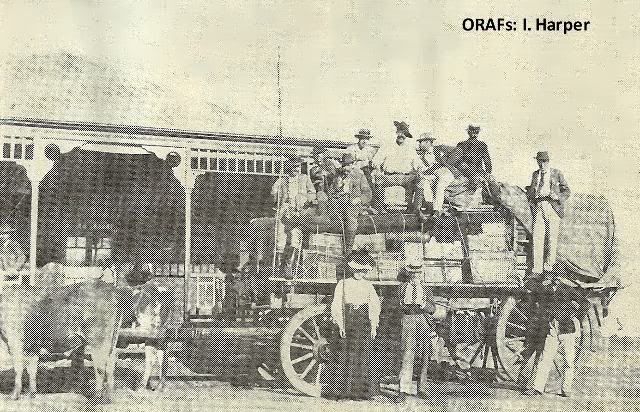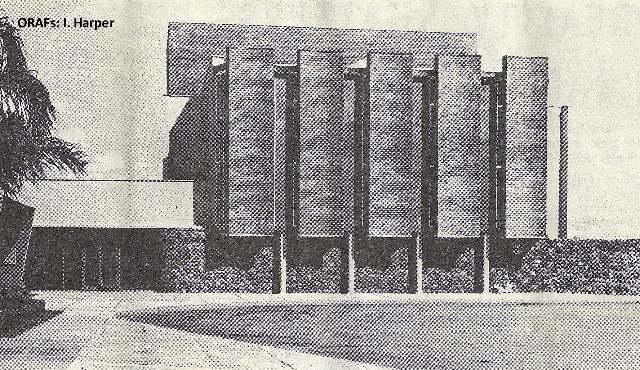Two weeks after the British flag was raised in Fort Salisbury in 1890, the first theatrical event in Rhodesia was staged in the newly completed fort — a play described as a "knock- about farce" in which the only female role was played by a 17-year- old boy.
A year later, the first theatrical society was formed, but there were several false starts before Salisbury managed to establish a regular society.
The first opera was in 1895 at the Royal Hotel, Umtali. It was Gilbert and Sullivan's "Trial by Jury". As there was a serious shortage of young women, members of the British South Africa Company Police played the bridesmaids. Unfortunately, the appearance of their large boots beneath full skirts detracted from the play and caused the first few rows of the audience to collapse with laughter.
Hotels
At this time, hotel dining rooms were used as theatres and it was not until 1896 that the first real "theatre" was built in Bulawayo. The Bulawayo Theatre of Varieties was a wood and iron shed with a flat earth floor and a small raised stage. Its construction was delayed by the Matabele Rebellion, but the Grand
Opening on October 31st 1896, made up for the delay with guest artistes from the Theatre Royal, Drury Lane, and other leading music halls.
Although the building was improved and proper seating put in, the front curtain was a green baize roller curtain suspended from a gum pole, and it stayed that way for several years.
During the Matabele Rebellion, a series of recitals was given in Bulawayo. The programme described the Bulawayo Siege Recitals as an offering to the "ladies of Bulawayo in appreciation of their patient endurance during the present trying crisis".
The first theatre in Salisbury was the Empire, which was later turned into a dress shop and was only recently pulled down. The Palace Theatre was first built in 1911, rebuilt in 1931, renovated a few years ago and finally pulled down recently to make way for a modern office block. It was also used for silent films, so that at times, rehearsals were conducted in dressing rooms behind the screen while the films were showing. In many cases, costumes for these shows were hired from companies in Johannesburg, 1 136 km away in South Africa.
There was also the Grand, built in 1913 and the Prince's Hall which was originally an hotel ballroom but was renamed in 1925 when a ball was given in honour of the Prince of Wales.
The Prince's Hall was used for everything from theatricals and fancy dress balls, to the first session of the Southern Rhodesian Legislative Assembly in May, 1925. Soon afterwards "Hay Fever" was produced by Lady Rodwell, wife of the Governor, who had been a musical comedienne before her marriage.
During the late twenties and early thirties, some famous show people visited Rhodesia, including Clara Butt, Galli-Curci, Sybil Thorndyke and Lewis Casson.
During the war years, shows were put on for the troops with many well-known stars including Noel Coward, who was guest artist in 1944.
Popular
Early theatre in Salisbury involved a number of people who later became well known—but not in theatre. One became a Governor, another a High Commissioner, a third a Mayor and quite a few became Members of Parliament.
Today, amateur theatre is so popular that there are over 35 groups throughout the country presenting regular productions — the war notwithstanding. In the heart of farming country it is not unusual to find modern, flourishing theatres, some with thatched roofs, which more often than not, have actually been built by the farmers themselves.

Members of a theatre company leaving the Cecil Hotel, Umtali, by ox-cart in 1898. They had played in the dining room to enthusiastic audiences.
Salisbury has two modern superbly equipped theatres. One is a 500-seat intimate theatre owned by an amateur society which employs a resident professional director, a paid staff of 25 and has assets worth half a million dollars. The luxurious bar, in keeping with the Rhodesian tradition, has contributed tremendously towards the cost of the theatre.
Opera
This particular group has incorporated an opera group and also has a junior section which meets regularly and stages one show a year. A second opera group and several other theatrical societies use this theatre, but hotels are once more "getting in on the act" with the introduction of Candlelight Theatre at one of the leading hotels.
Complex
There is also a much larger theatre, part of a cinema complex with a stage big enough to accommodate large-scale productions. The company specializes in bringing out professionals who are sometimes joined by local actors and actresses.
There have been a few local professional companies, but because of the small white population the players usually find that they can only work on a part-time basis and tend to emigrate to South Africa where there is sufficient work. Although theatre is completely multi-racial and there have been several promising black and coloured actors and actresses, generally European theatre does not appeal to the African population.
Festivals
Because of the many groups dotted around the country, the National Theatre Organization was formed to look after the collective, as well as individual, needs of all the amateur societies. It organizes two festivals a year, one for adults and one for schools, as well as seminars and lectures. It also has a library service and runs the business side of obtaining rights and scripts.
There is also a Play of the Year contest, sponsored by a local building society to encourage the writing of full-length plays. It is open to people of all races throughout the country. Cash prizes are only the first incentive, because any of the societies may then wish to produce it. The final achievement is in having a box office hit.
Children
Salisbury is very proud of its Childrens Theatre—a large group of enthusiastic youngsters who meet one a week to learn all aspects of stagecraft. The age limit is 14 and they do not pay subscriptions. Adults teach them, act with them and manage their shows voluntarily. They produce one show a year and all profits go to charity.
Rhodesian theatre has come a long way from those first days in Fort Salisbury, and with all the work being put into it now, it is assured of a thriving future.

The modern, well-equipped Charles Austin Theatre at Fort Victoria — a far cry from the early days when players used any available building to present their shows.
End of Article
Pictures by National Archives
Extracted and recompiled by, Eddy Norris for use on ORAFs, from Pages 4 and 5 of the publication Focus on Rhodesia 1978, which was made available by Iain Harper. Thanks Iain.
No financial gain is intended from producing these memories
Thanks to:-
My son, Paul Norris, for the ISP sponsorship.
Paul Mroz for the image hosting sponsorship.
Robb Ellis for his assistance.
Should you wish to contact Eddy Norris please mail me on orafs11@gmail.com
No comments:
Post a Comment